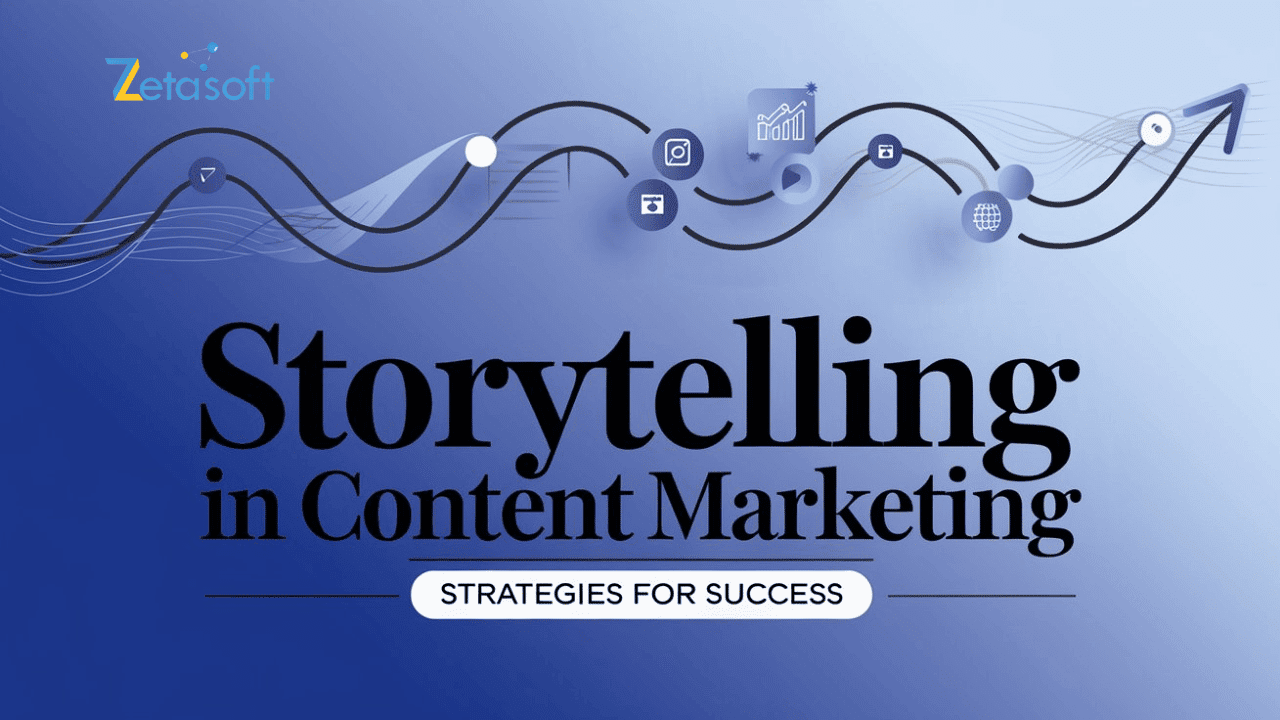More and more information is being presented to the consumer on daily basis and that makes the competition in the advertising industry even tougher. Traditional marketing messages often get lost in the noise, but one technique has proven to capture attention and drive engagement, a Narrative. Storytelling in content marketing can provide your brand with a unique selling proposition that makes it more real, easily memorable and credible to your target customers. In this article, we will discuss why storytelling has become the best tactic to implement in content marketing, the components in a compelling story and how you can apply storytelling to advance your brand.
Why Storytelling Matters in Content Marketing

It is also more necessary than ever to grasp why specific forms of storytelling have emerged to be the heart and key of content marketing approaches. Why are narratives effective than mere details, or numbers? This is due to inherent characteristics of people.
Emotional Connection
To its essence, it’s all about feeling. Thus, facts are useful in analysis while stories engage, prompt action and touch people’s emotions. They build the relationship between a company and the consumers which makes buying a certain product or using a particular service not just an act of buying a product, but an act associated with an emotion. These are some of the reasons as to why people will engage with the content, remember the brand message and become loyal customers if there is an emotional connection between them and the brand.
Stories Are Memorable
It has been established that our brains work in a way that they are able to retain narratives better than mere statements or fact sheets. Different dimensions of our brain such as sensory, emotional, and memory centers are involved in that process of stories; therefore, it becomes easier to remember. The main idea here is not only to produce content but to create that which will go viral and remain in people’s memory. Thus, through storytelling, you provide your content with a lasting message that people can take home.
Builds Trust and Credibility
It is evident that when telling stories, brands can easily create trust and credibility to what they are offering because of the truth behind the stories. Therefore, when you share the anecdotes that are lined up with the value proposition, mission, or story, you make your brand more relatable. Customers tend to believe those brands which tell more or less personal narratives and those which do not focus on making the sale.
Key Elements of Successful Storytelling

To establish an interesting story in content marketing story telling needs to take several things into account. These elements guarantee that the story you have to tell will find a response in your audience and thus contributes to the success of your marketing campaigns.
Know Your Audience
The first rule in creating any mode of telling a story rests primarily in the identification of an audience and what pertains to them. This is because individuals can be motivated to undertake an activity for innovation, tradition or for an adventure. It reveals the action of what is important to them, what is painful to them, and what they want? Audience demographic awareness helps a person tailor a story and figure out the type of stories that would suit them best.
For instance, if your audience is young professionals in the quest of career advancement, the themes of the tales may include striving for a promotion, building a career, and facing strong enemies. It is easier to make the spectators understand when the stories are well fit into the kind of audience you have.
Structure Your Story
It is therefore correct to say that every good story needs to have a structure, which usually contains three parts, that is, the starting phase, the middle part and the end part. The first page begins with the background information, characterization of the players i.e. your brand or your customer, and the issue. The middle of the story is some sort of conflict or some type of struggle, and the end is the payoff—typically a solution your brand offers.
When using narrative form remember that there has to be a flow of events that will engage your audience. This process should bring the brand or the product to an emotional attitude or a rational perception by the consumer. Being sequential and coherent the story maintains the viewers’ interest and gives them the prospect of a good ending.
Authenticity is Key
As consumers, people are able to distinguish fake content, therefore, whilst telling your stories, ensure to be real. Do not tell lies or emphasis points just to make a statement of fact. Therefore, avoid the use of shallow examples related to the trends, but use real-life scenarios, examples of the use of your brand or clients’ success stories that will reflect the essence of your brand.
There is also the need for brands to fully explain their campaigns, and the results they have gotten including the missteps. It is okay to share some weaknesses or failures with the public since it helps in creating trust with the audience.
Storytelling Techniques to Boost Your Content Marketing

So now that you know why storytelling is powerful and what kind of story is the best one, it’s time to look at practical tips that you can apply right away to get storytelling up and running in your content marketing strategy.
Stay tuned to Customer Narratives
Customer stories are one of the most effective forms of storytelling which you can use in your content marketing strategy. They also show situations where your product or service made actual people’s lives better in an actual way. In addition to helping you illustrate the features and advantages of your products or services, this not only symbolizes a way to influence the consumers’ decision because of the social proofs.
For instance, if you own a fitness company, then you can post before and after pictures of your customers who managed to lose weight by using fitness products from your firm. It is better to let them tell their experience, the struggles they face, and the triumphs they achieve using their own words. Apart from this, it also helps in establishing trust and influence over others motivating them towards constructive activity.
Incorporate ‘Data Storytelling’
For able to establish connections with numbers and data, they are usually viewed as rather arid. That is why the same feelings turn into something completely different if they are placed into a story. Do not just write down statistics from the information given, as the reader should know the story behind all the numbers. For instance, instead of merely stating that ‘Our sales improved by 50%’ elaborate on how the growth was realized, the measures that your team employed and the odds you had to accomplish.
You give the audience, which is you, a loophole to relate with the information you’re presenting by telling a story from the compiled data. This approach makes your content friendlier and makes it easier for people understand and digest the information you are passing across.
Brand story
A brand story is thus the first narrative a brand should adopt in its storytelling framework. It includes the values you hold, the mission you engage in and all the reasons you achieve them. An engaging brand narrative is not only the history of the company, but it is also the company’s goal and mission. What is unique to you, as a brand, and how do you impact your customer’s lives?
When employing the use of blogs, social media posts and other related content, ensure that you incorporate your brand story. It also assists in canvassing a continuous narrative that is friendly with the views of the audience hence creating rapport.
Which Type of Content Storytelling Should be Used

However, such an approach is flexible enough to be used with any type of content but there are some formats that are especially suitable for incorporating storytelling into your marketing strategy. Now let me illustrate several content types where storytelling can benefit and even excel.
Blogs and Articles
I think that the format of a blog is good for storytelling because one can go into the details of a story. When it comes to posting customer stories or case/lesson learnt, blog posts makes it easy to develop a good story as you provide good value. Therefore, when creating an article for your blog, ensure you highlight facts and ideas as well as share a story that captures the reader’s attention from the start.
For instance, if you are engaged in a travel agency, you may create articles that describe the journey of travelers who used your services. Share how your brand helped them throughout the journey, describe the difficulties they met and their experience they had with your brand.
Videos
The essence of meaning being conveyed through videos cannot be underemphasized since videos harness the use of visuals, sounds and emotions. From brand videos to customer reviews or samples, or even an insight to your business, video captures the audience’s attention and touches them in a way words can’t.
While developing a video, it is essential to share human’s story, which in turn will reflect the company’s values. For example, you can develop a short motion picture about your company: as to how it was established, the troubles encountered while forming, and the anticipated goals of the business. This makes the audience knowledgeable about your brand hence a close relationship is developed.
Social Media
Social media allow for sharing of short but sweet messages and especially those that are emotional. There are micro-stories formats such as Instagram, Twitter threads, and Facebook posts that are helpful in engaging the given audience. Take daily pictures of your brand’s processes, clients in celebration, and post them on the different social media platforms.
For example, you may do a sequence of Instagram Stories where your team captures their day in the course of work, the company culture, and people. This type of content is not only entertaining but also requires the audience to invest into the relationship with you.
Summary
In content marketing, storytelling has been known to be one of the most effective therapeutic approaches that help to reach out to your clients at an emotional level. This way you differentiate yourself and make your stories simple, memorable and believable so customers will remember you and develop a relationship with you.
Whether you’re telling customer stories, data or brand storytelling strategies explained in this article will assist you in achieving the best results. If you keep on polishing your storytelling technique, always bear in mind that the essence of content marketing is all about integrity, form, and feelings.

